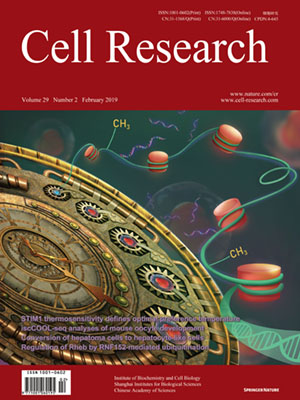
Volume 29, No 2, Feb 2019
ISSN: 1001-0602
EISSN: 1748-7838 2018
impact factor 17.848*
(Clarivate Analytics, 2019)
Volume 29 Issue 2, February 2019: 171-173
LETTERS TO THE EDITOR
Ciliary defects caused by dysregulation of O-GlcNAc modification are associated with diabetic complications
Fan Yu 1, Song Guo 1, Te Li 1, Jie Ran 2, Wei Zhao 1, Dengwen Li 1,
Min Liu 2, Xiumin Yan 3, Xiaoyong Yang 4, Xueliang Zhu 3 and Jun Zhou 1,2
1State Key Laboratory of Medicinal Chemical Biology, Colleges of Life Sciences and Pharmacy, Nankai University, 300071 Tianjin, China; 2Shandong Provincial Key Laboratory of Animal Resistance Biology,College of Life Sciences, Shandong Normal University, 250014 Jinan, Shandong, China; 3State Key Laboratory of Cell Biology, Institute of Biochemistry and Cell Biology, Chinese Academy of Sciences, 200031 Shanghai, China and 4Department of Cellular and Molecular Physiology, Yale University School of Medicine, New Haven, CT 06520, USA
Correspondence: Correspondence: Jun Zhou (junzhou@nankai.edu.cn)
Dear Editor
Diabetes is a chronic metabolic disease that has become a major epidemic worldwide.1 High blood glucose is thought to be the primary cause of most devastating long-term complications of diabetes.2 In addition to strict glycemic control, a number of therapeutics have been used to slow down the progression of diabetic complications.3 However, a majority of current therapies for most diabetic complications have shown disappointing results in clinical trials. Because these complications arise from a number of pathological processes, targets for early interventions that could lead to effective treatments are largely unknown. Clarification of existing pathways and elucidation of new mechanisms, especially those involved in the early stages of diabetic complications, are sorely needed to design preventative treatments. Interestingly, diabetic complications and ciliopathies share a number of symptoms, such as retinal degeneration and respiratory dysfunction.3 Therefore, we hypothesized that ciliary defects may underlie a subset of diabetic complications.
https://doi.org/10.1038/s41422-018-0114-7
FULL TEXT | PDF
Browse 1314


